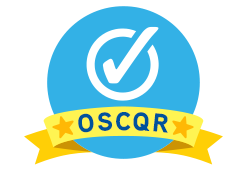Western Governors University (WGU) strives for quality in all aspects, with a key area of focus on, naturally, our courses. In fact, this commitment to quality is inherent in WGU’s Mission, “to change lives for the better by creating pathways to opportunity.” To fulfill our mission, pathways to opportunity must be reliable, engaging, and, ultimately, effective, none of which can happen without a focus on quality. However, quality can be difficult to define.
Defining Quality
With stakeholders that include students, faculty, and employers, the goals and ideals for quality can vary widely. Without a common definition of program, course, assessment, and learning quality, ironically, course quality may suffer when trying to satisfy too many competing priorities. Furthermore, it becomes difficult to identify appropriate metrics, find and repair issues, and maintain courses throughout their lifecycle.
For these reasons, WGU decided to adopt an industrywide rubric against which we could consistently measure the quality of our courses. Not only would an industry course quality rubric provide a central set of quality standards, but it would allow for communication about the quality of WGU products that is meaningful both internally to WGU and externally. After reviewing various course quality rubrics, WGU adopted the OSCQR Course Design Review scorecard as our primary method for measuring course quality.
WGU’s review of industrywide rubrics found that the OSCQR aligned well with WGU’s internal standards and practices. Additionally, its publication with the Creative Commons 4.0 license would also enable WGU to customize the baseline rubric as needed to support WGU’s philosophy and our unique competency-based education (CBE) model, which differs from many other online course models.
Existing Portfolio Audit
Upon adopting the OSCQR as our course quality standard, WGU began the process of auditing our portfolio of over 500 existing courses. Partnering with OLC for this audit was incredibly beneficial in that it provided WGU access to impartial reviewers who were highly familiar with the OSCQR standards. The scoring and commentary provided by OLC also allowed WGU to create internal processes and train internal reviewers to emulate the OLC-provided reviews for future products.
Results Analysis
When the audit of WGU’s existing courses was completed, WGU began a period of results analysis, reviewing the results both overall and across various categories (such as college and degree level). This analysis provided information about which OSCQR standards WGU courses were meeting, and which areas generally required improvement. This data enabled us to create realistic benchmarks for quality and prioritize course improvement efforts that focused on underperforming quality areas.
Customization
To ensure the OSCQR could be effectively used as a quality benchmark at WGU in the long term, WGU created an adapted version of the rubric to support usability for WGU products. For example, OSCQR standards for platform, technology, orientation, and communication were omitted in the WGU adaptation. While WGU recognizes these elements as supportive of quality, we use a standard approach for these areas across all courses through our student learning environment. Because these scores would not vary from course to course, the WGU adaptation removed them to ensure that swift and specific action can be taken for any score that does not meet the benchmark for a particular course.
Additionally, the WGU adaptation removed items that are not supported by WGU’s learning philosophy. WGU’s focus on competency-based education emphasizes autonomy and flexibility in learning. “A key characteristic that distinguishes courses in a CBE program from other courses is that students can accelerate to completion. They make progress toward course objectives based on demonstrating the knowledge and skills required at each step (or module) along the way. That is, learning becomes the constant—and is demonstrated through mastery of learning objectives, or competencies—and time becomes the variable” (What is CBE?). Where achieving competency is WGU’s primary priority as a competency-based learning provider, quality standards requiring certain types of interaction were removed from the rubric to ensure alignment with WGU’s learning model.
Lastly, WGU’s adaptation of the OSCQR extended the timeframes associated with the scores. Because WGU produces hundreds of new courses each year and executes regular improvements to existing courses to ensure they are accurate and up-to-date, remediation timeframes that are given in days, rather than hours, are more meaningful to the institution in understanding how much effort a below-benchmark score will require to remediate.
Implementation
Following the results analysis for existing WGU courses and the rubric adaptation, WGU implemented the OSCQR scoring for all newly developed courses. By aligning to the OSCQR standards throughout course development, we ensure that each new WGU course created has been guided by clear standards for quality results. The roles that support development have been trained on how to meet OSCQR standards when developing products. Courses are scored before launch by an internal Quality Assurance team, providing development teams the opportunity to remediate any quality issues before the product goes live to students. If concerns about a course’s quality arise following its launch, the OSCQR scores are revisited as part of the quality analysis to determine whether the standards were applied correctly. That input helps us ensure the OSCQR review is a valid indicator of course success going forward.
Conclusion
While the focus on quality in learning is a universally accepted need, starting with a common definition for quality has provided WGU a clear roadmap for supporting quality, both in the development and maintenance of courses. Combined with quantitative performance data and qualitative feedback from students and other stakeholders, we have a high level of confidence in our ability to create and support quality courses for the benefit of WGU students.
The Online Learning Consortium (OLC) and SUNY Online have announced the release of an update to the free OLC OSCQR Course Design Review Scorecard. This OSCQR 4.0 scorecard is the first online course quality rubric to account for recent U.S. Department of Education (DoE) regular and substantive interaction (RSI) regulatory requirements for online and distance education.


